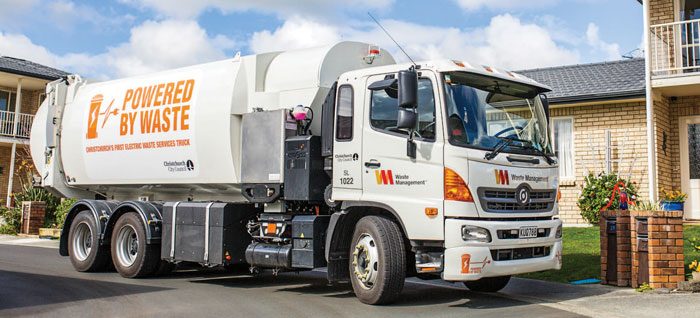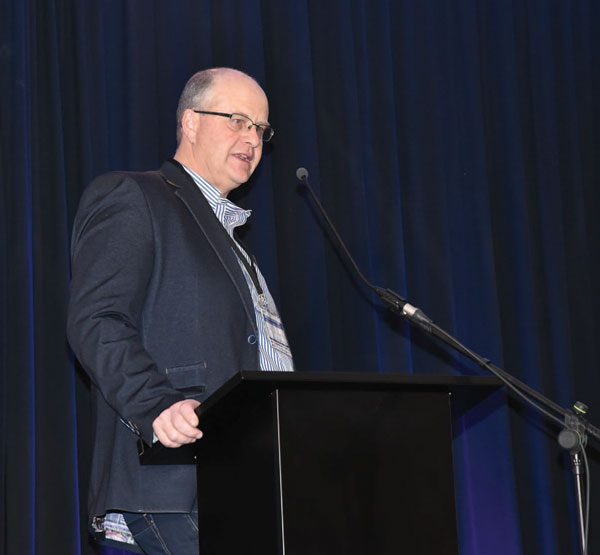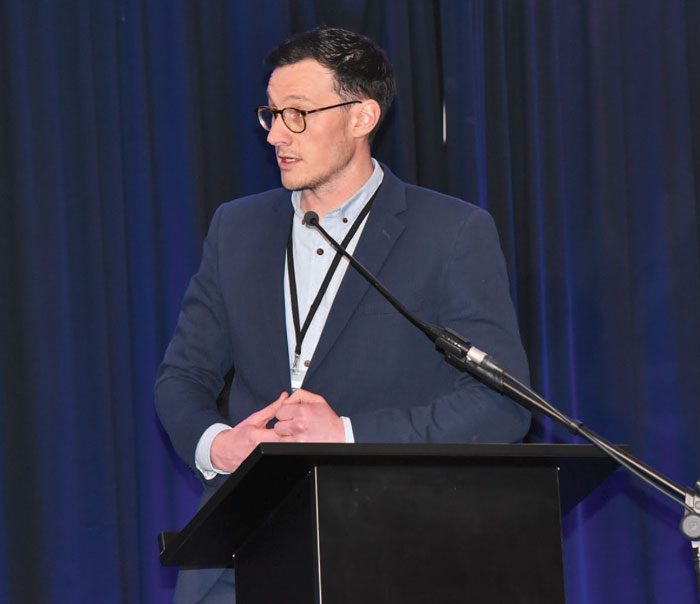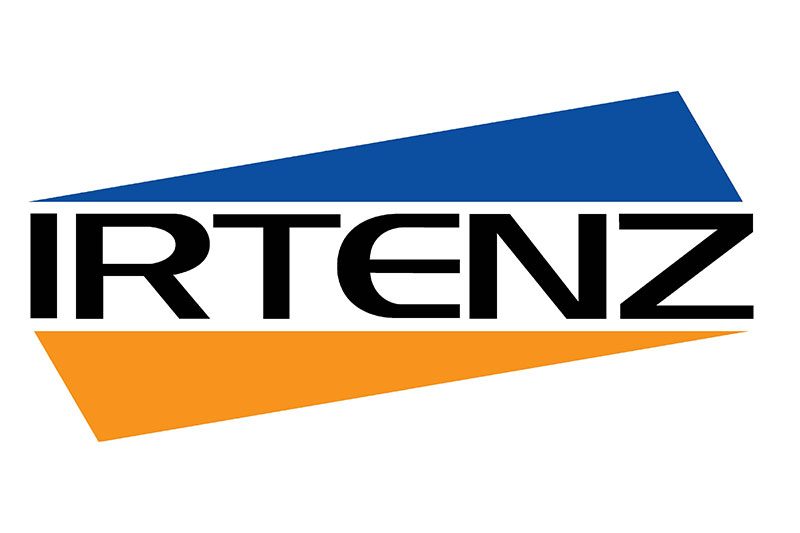IRTENZ CONFERENCE 2019 – Better productivity from the rain
Keynote speaker – Scott O‘Donnell, board member, Richardson Group
 New Zealand needs to become more productive, its various stakeholders and interest groups working together efficiently, so that the country can take its wares to the world. That was the overarching theme to Scott O‘Donnell‘s keynote presentation at the 2019 IRTENZ conference. However, to bring that vision to fruition, there are numerous stumbling blocks that need to be overcome – on the parts of government, the wider transport industry, and customers alike – that O‘Donnell indicates will require a concerted effort and willingness from all parties. He cites numerous points of concern. One of the biggest O‘Donnell sees at the moment is compliance. “When you‘re a company of our size you can get it wrong and we know that, occasionally, we do. We‘ve got no problem in that instance taking a smack on the chin, but what drives us nuts is when we‘ve got competitors who aren‘t being held to the same account. We know there are some challenging operators out there who are breaking rules to survive,” he says.
New Zealand needs to become more productive, its various stakeholders and interest groups working together efficiently, so that the country can take its wares to the world. That was the overarching theme to Scott O‘Donnell‘s keynote presentation at the 2019 IRTENZ conference. However, to bring that vision to fruition, there are numerous stumbling blocks that need to be overcome – on the parts of government, the wider transport industry, and customers alike – that O‘Donnell indicates will require a concerted effort and willingness from all parties. He cites numerous points of concern. One of the biggest O‘Donnell sees at the moment is compliance. “When you‘re a company of our size you can get it wrong and we know that, occasionally, we do. We‘ve got no problem in that instance taking a smack on the chin, but what drives us nuts is when we‘ve got competitors who aren‘t being held to the same account. We know there are some challenging operators out there who are breaking rules to survive,” he says.
The next challenge O‘Donnell sees is in efficiency – or the lack thereof. Here, he points out two recent trends affecting the efficiency of the transport industry. The first is load amalgamation. “Huge amounts of waiting time, lots of half loads, and the cost of delivering that service is expensive when it doesn‘t need to be,” he says about the livestock sector in particular. Waiting time is a particular issue. “If our trucks could all work for their full 13-hour shift every day, we‘d need far fewer trucks and use much less fuel – but we know we can‘t do that because of a whole range of constrictions in the channel.” He adds that congestion at ports and by traffic exacerbates the situation. “You risk going broke by moving loads too slowly. Long term, we have to find a way forward from some of those things.”
One option, says O‘Donnell, is doing things at night. Another is automation; an “interesting curveball.” There‘s no question that technology can steer the truck from point A to point B – but there are lots of things it can‘t do. There will always be an operator in the cab doing something. But, hopefully, it will allow relief for that driver. If they get on the highway and hit that button, and effectively do something else for a bit of time, then I think it‘s a good thing for road transport.” Allied to automation is the rise of alternative power, and in this regard he suggests that none of the current options are a viable replacement for diesel – at least regarding linehaul applications. Regarding electric power, O‘Donnell says that the challenges include New Zealand‘s hilly terrain, higher purchase prices, the demand placed on the grid through charging, and the weight penalty of the batteries that will result in an increase in the number of trucks needed to move payload. “There‘s no question those trucks will be a nicer workspace – smoother, quieter, high levels of automation. But I see electric, in the short-term, being suited to town delivery and short-haul work.
I think the line-haul function will stay with diesel for a long time.” He says that New Zealand is very well placed for hydrogen power because, effectively, the country can produce a lot of it from renewable electricity. “The challenge we face is it takes a phenomenal amount of electricity to process the hydrogen from the atmosphere into some useful state. If we can get the price down to 1c/kWh and generate it off-peak, there could be a good outcome for New Zealand. Scandinavian countries are very strong on hydrogen because they have lots of renewable electricity. There are some forklift trucks and light vehicles running hydrogen, but we‘re yet to see much in the heavy space,” he says.
Regarding culzean gas, O‘Donnell says that huge amounts of time have been spent trying to figure out if it can work. “That‘s been pretty much shelved at this stage. The cost of the culzean gas is not much but the cost of creating distribution networks is huge. Given we‘ve got ‘dead dinosaur‘ networks in place everywhere, the cost of creating those networks is quite a challenge – as it is for hydrogen and electricity.” The next big challenge for New Zealand that O‘Donnell outlines is its infrastructure and the willingness of the powers that be to spend wisely on it. As he says, New Zealand doesn‘t lack capital, but the situation where the people who control the capital want to spend on things that are good for the country.
“If I had a dream it would be that we had four lanes from Whangarei to Invercargill. The challenge for road transport is not speed, it‘s getting the number of kilometres done in a given hour. I‘m sure those who do the trip from Whangarei to Hamilton pull their hair out. The inefficiency is mindboggling. I know those who do a lot of work in the Auckland market risk going broke because of congestion.” In all, O‘Donnell says that constraints in the system are stopping efficiency. “I‘d like to see New Zealand become much more productive,” he says. “We are very efficient at turning rain into grass, wine, eggs, milk powder… But we‘re not quite so good at creating more value for that product nor so getting it to the end consumer. We‘ve got to find a way to take the rain, turn it into something that has real value and sell it to the world market.”
Not wasting the moment
Sam Donaldson, Waste Management‘s senior project engineer – electric vehicles, spoke at August‘s IRTENZ conference about the company‘s electric fleet implementation. “We‘re always looking for new technologies that can help us do what we need to do better to help the general population.” Donaldson said Waste Management found approximately 75 percent of its total operational emissions profile came from burning diesel, and realised it could make a huge dent in the emissions load by converting their fleet to electric. “In 2015 we started with passenger vehicles. We have nearly every make of electric vehicle available in New Zealand in our passenger fleet, but the main goal was always going to be electric trucks.” Fleet data told them one electric truck saves about 125 litres of diesel per day. “Obviously that varies with the different trucks we have, we‘ve got a whole range from little flat decks up to 58-tonne truck and trailers, but that‘s the average, and across our fleet of around 800 trucks it‘s close to 100,000 litres of diesel every single day. As we move towards converting this entire fleet to zero exhaust emissions, it‘s going to make a really big impact.” Donaldson said electric trucks were perfect for metro and last mile deliveries, and waste collection.
“We‘re not talking about a lot of linehaul work here, we‘re talking about trucks that do about 200 kilometres a day on average and then return back to base. That return to base is quite important because that enables us to go out, do our collections through the day, come back and have overnight to charge.” Another aspect of waste collection that makes electric vehicles ideal is its stop-start nature. “For example, a residential collection sideload truck would stop 1200 times a day. In a diesel truck, every time you do that you‘re losing energy through friction on the brakes. We can capture some of this energy through a regenerative braking system in our trucks. So far we‘re getting up to 30 percent of the energy we use for driving returned to the battery through regenerative braking.”

Photo: Scott O‘Donnell addresses the delegates at IRTENZ 2019.
Although Waste Management was committed to an electric truck programme, they weren‘t able to buy electric trucks in New Zealand – something they‘re still unable to do. “The availability of electric vehicles here is obviously a problem. If we want them, we‘re going to have to build them ourselves. “We had a few smaller trucks that were hybrids, which we were quite happy with, but a full electric truck was where we wanted to be. We were keeping a close eye on what was happening around the world, and we found a company in Europe, EMOSS. They had a good track record of converting trucks to electric. They were able to provide us with the technology, the components, the support and the expertise we needed to be able to convert our trucks in-house.” Waste Management‘s first box body truck was built as a diesel truck in New Zealand and then sent to The Netherlands where it was converted by EMOSS to electric. “It was very much an R&D project for us, we had some expectations about what it would be like but it really exceeded our expectations. The battery was sized to do a day‘s work, but we weren‘t really sure how it was going to work out.
We took it out and did a wide range of testing with it, we used it on many different routes for many different jobs, and this truck is still running around now, easily doing two, and often three day‘s work on a single charge. A little bit over-engineered but it really helped to prove the concept.” Since that first truck, Waste Management has slowly been growing its electric fleet, starting with a side-load collection truck based on an Isuzu chassis, and another based on a Hino chassis. “Structurally they were quite a departure from the box body, a lot larger truck, a very large hydraulic demand, we weren‘t really sure how the energy use split was going to be between moving the heavy truck and then also the use of the hydraulics.” Donaldson said that there was a bit of a development process to see how much energy was used through the whole process. “We‘ve also done other trucks in the 16-tonne range that are operational at the moment. They easily do their day‘s work and come back and charge overnight, ready for the next day. They‘ve been exceptional.”

Photo: Waste Management‘s Sam Donaldson told delegates that even with the cost of conversion, electric trucks offer their business a positive whole of life cost now.
From here, Waste Management will be focusing on converting trucks in the 11 to 16 tonne range. Donaldson said more than half the fleet consists of trucks this size and the conversion is reasonably simple. There are nine operational trucks in the current fleet, and others at various states of conversion. “We‘re going to ramp up our conversion process. So far we‘ve saved about 26,000 litres of diesel, and over 69 tonnes of carbon dioxide, so that‘s not a bad start.” In 2018 Waste Management received funding to open New Zealand‘s first workshop dedicated to converting diesel trucks into electric vehicles. “Our electric vehicle innovation hub, or as we prefer call it, our workshop, is an important part of what we do, so our intention is that for the foreseeable future we‘re going to be converting all of our diesel trucks to electric in-house.” At the moment the company brings in new cab chassis and converts them to electric, but later this year they will start converting used trucks.
“We‘ve got a couple of trucks that are out in our fleet that are starting to run up some maintenance bills, so we‘re going to look to bringing them in and converting them to electric.” The goal is to have 20 converted trucks by the end of 2019. Donaldson says the benefits of changing the fleet to electric are already apparent. “Significantly reduced fuel costs for a start – the cost to fuel our electric trucks is 80 to 85% cheaper than diesel vehicles. The regenerative braking aspect is an important part of this. With the stop-start collection we‘re recovering energy and putting it back into our batteries. “We‘re coming up to three years into this project and we‘re starting to get some data that maintenance costs are around half that of the diesel equivalent. At the same time we built the first electric box body truck, we also built a number of diesel trucks that have been used in the same fleet, so we have some very good direct comparisons between a diesel and electric truck doing exactly the same duty. As the trucks age it will be interesting to see how they compare.”
As expected, the initial cost of the first few electric truck conversions was high, but Donaldson said based on the data gathered so far, the total cost of ownership of the electric trucks is expected to be lower than the diesel equivalents. As the technology becomes cheaper and OEMs start producing higher numbers of electric trucks, this will also lower the cost. “There are certainly some challenges with battery-electric trucks and technology. What we‘re doing is purchasing a fleet of vehicles fitted with high quality components and removing the most expensive part of that diesel vehicle and replacing it with electric equipment. It‘s certainly more expensive, especially given the very low production runs we‘re doing. But from our point of view, more importantly than the capital cost for us is going to be the total life ownership costs of the vehicle, and that‘s where we‘re looking to be better off.” Donaldson said there is also an increased tare mass on Waste Management‘s battery-electric trucks. “It‘s not insignificant, but we do have the advantage of designing and building ourselves. We can move the components around to suit the vehicle, so for a particular vehicle that is normally rear-axle heavy, we can move some of the components further forward and vice versa.” Another challenge is upskilling not only the operators of the vehicles, but also the technicians who work on them.

“There are significantly fewer parts on an electric truck but it‘s a different set of skills. When we have a problem with an electric truck we go to the truck with a laptop; that‘s basically our diagnostic tool that solves most of the problems we have. The drive system runs at a significantly higher voltage, about 750 volts DC, so we can‘t just have an auto electrician go and look at the high voltage system of our electric trucks, it needs to be a specifically skilled person who can do that. And there are special tools that come along with that. Workshops are going to start to look a little bit different in the future.” Donaldson said driving a battery-electric truck was different from driving a diesel, and overcoming driver aversion was one of the biggest challenges the company faced.
“It‘s new technology that the operators are sometimes sceptical of. These are true-blue diesel guys and to say to them ‘here‘s your new truck, it‘s full electric, and it‘s completely silent‘ – you get some interesting looks, but a really important part of what we‘re doing is getting the operator buy-in. “We spend a lot of time with the drivers and tell them about how it works, make sure they understand the technology, and make sure they understand the advantages. We have some ex waste truck drivers who we send out with new drivers to make sure they‘re ready and confident in what they‘re doing. We find that once they get over that initial hesitation, once they start driving them, we get nothing but positive feedback.” Donaldson said the electric trucks had high torque at low speeds and drivers pulling out at intersections or onto the motorway with a fully laden electric truck were often surprised to discover the truck reacted in a similar fashion to a car. “Obviously it‘s very silent too. On an electric truck there is no transmission, just a direct drive electric motor straight to the diff. This is particularly helpful at low speeds, so with the slower speed start-stop driving there are no gear changes, it just takes off smoothly and quietly. Driving it is effortless. It‘s comfortable, it‘s quiet, you don‘t have the vibrations, so overall it‘s a better working environment for our drivers.” In addition to ramping up its conversion programme, Waste Management is also increasing the number of charging points within its sites, as currently every vehicle it puts on the road has its own dedicated charging station. “We install and we monitor them ourselves. As the fleet increases, we‘re going to have to look at smart control of our chargers and load sharing of our electric charging network. It‘s not only for our truck fleet, we have a large fleet of electric passenger vehicles as well.
We‘re doing quite a lot of work on installing chargers, but it‘s also how to manage those chargers and how we ensure that our electricity supply is going to be sustainable enough. “We‘ve been collecting as much data as we can; we‘re trying to analyse every aspect of what these trucks do, how many kilometres they‘re doing, their energy usage, their maintenance costs, all the breakdown, everything. It‘s all a part of not only improving what we‘re doing and the engineering behind our trucks, but also validation of the cost of the project.” Donaldson said Waste Management was looking forward to OEMs supplying electric trucks. “We see our conversion process will be going for quite a bit longer, but as soon as OEMs will let us have some working trucks we‘ll be into it. As well, things like various technological developments, higher energy densities, perhaps some new chemistries, uses for second- and third-life batteries, will be coming. We will be looking into that in terms of what we can do with our batteries once they are no longer fit for use in our trucks. It‘s likely to be something along the lines of stationary storage or grid supplementation and then material recycling. As a waste company we have quite an interest in what happens with the materials in the batteries and the copper after it‘s finished its useful life. There will certainly be some developments coming on that front.”
Read more
IRTENZ Conference 2023 – PBS
0 Comments12 Minutes
IRTENZ Conference 2023
0 Comments12 Minutes
IRTENZ Conference 2023
0 Comments20 Minutes


